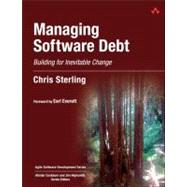
What is included with this book?
Introduction xxi
Acknowledgments xxxi
About the Author xxxiii
Chapter 1: Managing Software Debt 1
Where Does Software Debt Come From? 1
Software Debt Creeps In 3
Software Asset Depreciation 5
Business Expectations Do Not Lessen as Software Ages 12
Summary 14
Chapter 2: Technical Debt 15
Origins of Terminology 16
Patterns of Technical Debt 19
Acknowledging Technical Debt 22
Summary 30
Chapter 3: Sustaining Internal Quality 31
Discipline in Approach 31
Summary 52
Chapter 4: Executable Design 55
Principles of Executable Design 55
Executable Design in Practice 59
Summary 79
Chapter 5: Quality Debt 81
Quality as an Afterthought 81
Indicators of Quality Debt 85
Test Automation 93
Summary 104
Chapter 6: Configuration Management Debt 107
Overview of Configuration Management 108
Responsibilities for Configuration Management 109
Release Management 115
Branching Strategies 123
Documenting Software 126
Summary 128
Chapter 7: Design Debt 131
Robustness 131
The Cost of Not Addressing 135
Changeability 138
Review Sessions 146
Summary 150
Chapter 8: Designing Software 153
Application Design 153
Team Tools for Effective Design 163
Summary 171
Chapter 9: Communicating Architectures 173
The Three Levels of Architecture Perspective 173
Architecture Is S.A.I.D. 178
Modeling 186
Summary 188
Chapter 10: Technology Evaluation Styles 191
The Need for Technology Evaluation 191
When to Conduct Technology Evaluations 196
Summary 198
Chapter 11: Platform Experience Debt 199
Defining Platform Experience 199
Sharing Knowledge 203
Collaborative Team Configurations 206
Importance of Relevant Experience 217
Summary 219
Appendix: What Is Agile? 221
Index 229
The New copy of this book will include any supplemental materials advertised. Please check the title of the book to determine if it should include any access cards, study guides, lab manuals, CDs, etc.
The Used, Rental and eBook copies of this book are not guaranteed to include any supplemental materials. Typically, only the book itself is included. This is true even if the title states it includes any access cards, study guides, lab manuals, CDs, etc.